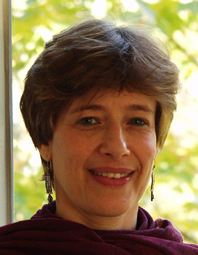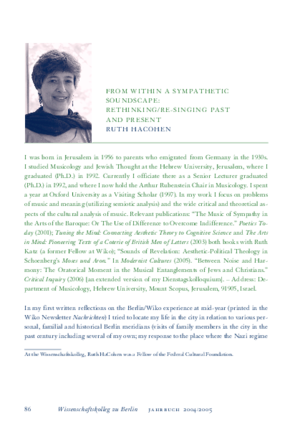
Ruth HaCohen, Ph.D.
Senior Lecturer in Musicology
The Hebrew University of Jerusalem
Born in 1956 in Jerusalem, Israel
Studied Musicology, Jewish Thought, Philosophy, and Literary Studies
at the Hebrew University of Jerusalem
Fellowship
Bundeskulturstiftung-Fellow
Project
Holy Resonance: Jewish and Christian Approaches to Religious-Musical Experience
My work in Berlin will consist of comparative research on the way monotheistic religions (especially major trends in Judaism and Christianity, since early modern times) have enlisted music to advance their goals. Compared with the massive research on textual and ritual components of religious practices, the role of music in religious world-making has been relatively neglected. Of particular interest to me are the uses of music as a nonverbal means to direct the interpretation of religious texts and shape the emotional, aesthetic, and theological dimensions of the wider religious experience.Exploring the ritualization of the flow of time through music, for example, may give special insight into specific embodiments of monotheistic "temporalities" such as the "Day of Judgment" and other modes of celebration and commemoration. I will treat a host of questions opened up by texts shared by Christians and Jews, like Psalms and The Song of Songs, which were differently interpreted musically. I plan to examine also the issue of musical representation of divine voices, including its implications for attitudes toward idolatry, aniconism, and the "musical sublime"; the ways each religion considered music "vagrant" nature and its secularizing/sacralizing potential; the distinctions they created between normative and censured music; and finally, inter-religious and intra-religious exchanges facilitated by musical experience.
Recommended Reading
Katz, Ruth and Ruth HaCohen. Tuning the Mind: Connecting Aesthetic Theory to Cognitive Science. New Brunswick, NJ: Transaction, 2003.
-. The Arts in Mind: Pioneering Texts of a Coterie of British Men of Letters. New Brunswick, NJ: Transaction, 2003.
HaCohen, Ruth. "The Music of Sympathy in the Arts of the Baroque: or the Use of Difference to Overcome Indifference." Poetics Today 22, 3 (Fall 2001): 607-650.
-. Arnold Schönbergs 'Kol Nidre': Versuch einer Begriffsbestimmung jüdischer Ästhetik in der Moderne. Schriftenreihe Ha'Atelier Collegium Berlin 5 (2004).
Colloquium, 06.05.2005
Between Noise and Harmony: Musical Entanglements of Jews and Christians
Noise and harmony can be relative terms like fiction and reality. Their respective attachment to the sounds of different groups, in this case Christians and Jews, has been aesthetically, religiously and socially loaded. This acoustic scheme was applied to actual musical practices of churches and synagogues dating from the beginning of the second Christian millennium. Its re-evocation, in the wake of modern anti-Semitism (e.g. by Richard Wagner), likewise refers to musical and other artistic developments of the time, first and foremost to the meteoric success of several composers of Jewish origin in the first half of the nineteenth century (especially Felix Mendelssohn and Giacomo Meyerbeer), as well as to certain internal reformations of synagogal music in the course of that century.
My purpose is to explicate this musical and the vocal dimension as a part of the larger entanglements of Jews and Christians. In my analysis, I try to show the ways artistic images, texts and sounds are welded together into worlds abiding by rules of their own, interacting, as such, with the audience which they address. Such analysis of "works as worlds" involves stylistic, aesthetic and semiotic aspects, as well as interpretation of the socio-historical contexts in which the works appear, including the history of their performances and reception. Viewing the main arena of the entanglement in the genre of oratorio, I interpret some of its specimens as powerful vehicles for inclusion and exclusion, assimilation and demarcation. The oratorio, developed in the 17th century to enhance religious identity and difference, paradoxically highlighted an open-ended dynamic form, overcoming divides between reality and fiction, present and past, insiders and outsiders. Both Jews and non-Jews (including Bach, Lessing, Handel, Mendelssohn, Heine, Meyerbeer, Wagner, George Eliot and Schoenberg) seized this dynamic form, or some of its components, applying it in various artistic contexts, musical as well as literary, thus constantly redrawing the vocal boundaries of Christians and Jews.
Publications from the Fellow Library
HaCohen, Ruth (New Haven, 2011)
The music libel against the Jews
HaCohen, Ruth (2010)
Sounds of revelation: : aesthetic-political theology in Schoenberg's Moses und Aron
HaCohen, Ruth (2009)
HaCohen, Ruth (s.n., 2009)
Bach : text and drama Understanding Bach: web journal of Bach Network UK ; 4
HaCohen, Ruth (2006)
HaCohen, Ruth (New Brunswick, NJ, 2003)
The arts in mind : pioneering texts of a coterie of British men of letters
HaCohen, Ruth (2003)
HaCohen, Ruth (New Brunswick, NJ, 2003)
Tuning the mind : connecting aesthetics to cognitive science
